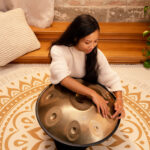The handpan is a mesmerizing musical instrument known for its ethereal, soothing sounds and unique, UFO-like shape. Often referred to as a modern percussion instrument, the handpan is a melodic steel drum with a rich resonance that captivates players and listeners alike. It’s crafted from two curved metal shells, carefully shaped to produce a harmonious range of tones. The instrument is primarily played by gently tapping or gliding fingers and palms across its surface, creating rhythmic melodies.
Unlike traditional drums, the handpan is tuned to a specific scale, making it simple to produce harmonious sounds even for beginners. Each handpan is unique in its tuning, giving it a personal character that resonates differently with every player. The versatility of the handpan has led to its use in various settings, from meditative practices and yoga to live performances and even sound therapy sessions. Its enchanting sound makes it more than just an instrument—it’s an experience.
History and Evolution of the Handpan
The handpan, although relatively new, has a fascinating history rooted in innovation. It originated in 2001 when Swiss inventors Felix Rohner and Sabina Schärer of PANArt introduced the Hang, the first instrument of its kind. Inspired by the steelpan drums of Trinidad and Tobago, they sought to create a more portable and melodic percussion instrument. The Hang gained widespread admiration for its soothing, resonant tones, sparking global interest. Over time, other makers adapted the design and techniques, leading to a variety of handpan styles and tunings. Today, it’s celebrated worldwide as an instrument that bridges traditional craftsmanship and modern creativity, while its evolution continues as artisans refine its acoustics and form.
Anatomy of a Handpan
At its core, the handpan is composed of two steel shells fused together to form a hollow, dome-like structure. The top shell features tone fields arranged around a central note, called the Ding, which is often the lowest note on the instrument. Each tone field is meticulously crafted to produce a specific pitch, contributing to the handpan’s harmonious sound. The bottom shell often includes a circular opening, called the Gu, which helps project its acoustic resonance. The combination of these elements gives the handpan its distinct, meditative sound quality. Its minimalist yet sophisticated design makes it a work of both art and engineering.
How to Play the Handpan
Playing the handpan is a delightful experience that relies on intuitive touch and rhythm. Unlike traditional percussion instruments, it’s played with the hands and fingers rather than sticks or mallets. Beginners can start by striking the tone fields gently to produce clear, melodic notes, gradually experimenting with patterns and dynamics. The circular arrangement of notes encourages creativity, as players can flow seamlessly between tones to create melodies and rhythms. While it may take practice to master advanced techniques, the handpan’s forgiving nature allows even novices to produce beautiful music from their first attempt. Its tactile playstyle connects players deeply with the instrument and their music.
Choosing the Right Handpan
Selecting a handpan requires thoughtful consideration, as each instrument is unique in its sound and feel. The primary factors to consider are the scale, tuning, and craftsmanship. Scales range from major and minor to exotic variations, and your choice will depend on your musical preference and intended use. High-quality handpans are handcrafted by skilled artisans, often making them an investment. It’s essential to test different handpans, if possible, to find one that resonates with your personal style. Reputable makers, such as those featured on platforms like SonoDrum, offer instruments that balance tone quality, durability, and artistry.
Applications of the Handpan
The handpan’s versatility has made it a popular choice for a range of activities. Its calming, resonant tones are ideal for meditation, yoga, and sound healing, where it helps create a tranquil atmosphere. In the music world, it’s cherished for its unique sound, blending seamlessly into genres from world music to ambient and experimental styles. Many performers also use it for live concerts, busking, or even recording projects, as its enchanting sound captures audiences’ attention. Additionally, the handpan is a favored tool for personal relaxation and mindfulness, allowing players to unwind through its expressive melodies.
Caring for Your Handpan
Proper care is essential to maintain your handpan’s sound quality and longevity. Regular cleaning with a soft, damp cloth helps remove dirt and oils from its surface. To prevent rust, apply a thin layer of protective oil designed for steel instruments. Handpans should be stored in a dry, cool environment, away from extreme temperatures and humidity. When not in use, keeping it in a padded case offers protection from scratches and accidental impacts. By following these simple steps, your handpan will continue to deliver its magical sound for years to come.
Conclusion
The handpan is much more than an instrument—it’s a gateway to creativity, mindfulness, and musical expression. With its rich history, elegant design, and enchanting sound, it has captured the hearts of musicians and enthusiasts around the world. Whether you’re drawn to its meditative qualities or its artistic versatility, the handpan offers a unique journey into music that is both accessible and profound. Through proper care and practice, it becomes not just an instrument but a cherished companion in your musical and personal explorations.








